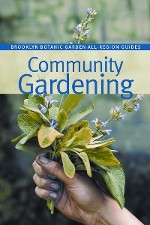I got this book from the local public library when I signed up to join a community garden in Saint Paul, Minnesota (USA). Although I had heard plenty of things about it from other people (or in the media), and had also met some people who had been involved in such projects in the past, I thought it was the right time to learn a bit more about it.
So, what is a community garden?
(...) The best known types of community gardens, perhaps, are the allotment gardens in Europe and North America that were established during World War II to aid the war effort, keep citizens occupied, and provide healthy and nutritious food (particularly important because canning supplies were redirected to munitions). These victory gardens provided the prototype for many gardens today that focus production and offer individual plots and common resources.
But a community garden is, in fact, anywhere a "community" of people joins together to garden. It is a shared green space that is planned and maintained by some community members for the use and enjoyment of the entire community. A community garden can be a shared garden beside a group of homes (including apartments and other residences), a linear street-side garden, or a school garden. A block association might form to care for street trees or beautify homes in a grou[ project, or a social service or religious organization might engage members to practice gardening on its site. A community garden can even be on a roof or indoors. A courtyard in an apartment building with a beautiful garden where neighbors work together can be a place to connect with others. Think about all the spots in your neighborhood that are potential community gardens.
(Ellen Kirby & Elizabeht Peters: Community Gardening, p. 9)
In other words, community gardens are a relatively new phenomenon. Something that started in the 20th century. As a matter of fact, community gardens are pretty much an urban creation. They started when people who lived in urban settings found the need to either plant their own food to supplement their diets (for instance, at a time of war) or wanted to create a community setting where neighbors could share their interests while getting a bit closer to nature. In this sense, the spread of environmental awareness in recent times has definitely provided a significant push to the idea. One would imagine that they are pretty much not needed in rural areas, of course. In those settings, they are actually ingrained in everyday life.
But, what are the main benefits of community gardens?
In due course, the presence of a community garden often leads to improved community services, like police support or sanitation pickup, or amenities like street-lights. Turning a rubbish-filled vacant lot into an oasis of beautfy improves the appearance of a street and strengthens housing values. Likewise, a tree-lined street where the trees are well tended by a community group affords a more attractive appearance and also improves the environment by reducing heat and filtering polluted air. Gardens can also teach about recycling through composting, helping to reduce solid waste and thereby saving taxpayers money. Open space, when cared for, generally increases the value of property, the satisfaction of residents, and the neighborhood's quality of life.
(Ellen Kirby & Elizabeth Peters: Community Gardening, p. 10)
In other words, notice that we are discussing, once again, the role of community gardens in an urban setting, for that is precisely the context where they appear. One wonders if perhaps the idea grew as a consequence of our progressive detachment from nature, especially when we started to notice that such lifestyle implied certain negative consequences that we had never imagined. It is almost as if we need to have some sort of connection to the natural world, in one form or another, to live a relatively happy life, and the progressive expansion of an urban lifestyle and the sprawl pushed us closer to anything tinted green. Thus, community gardens can be used for therapeutic purposes, to strengthen a community, to teach kids from a nearby school, to plant your own food, learn new skills, have some fun with friends and family...
In any case, this book, Community Gardening, is a short introduction to the topic at hand. It quickly tells us what community gardens are all about, lists their benefits, discusses some basic concepts about the skills and tools needed and, above all, provides plenty of resources to anyone interested in starting or joining a community garden. As such, it served the purpose I had in mind.
Entertainment Factor: 6/10
Intellectual Factor: 6/10
